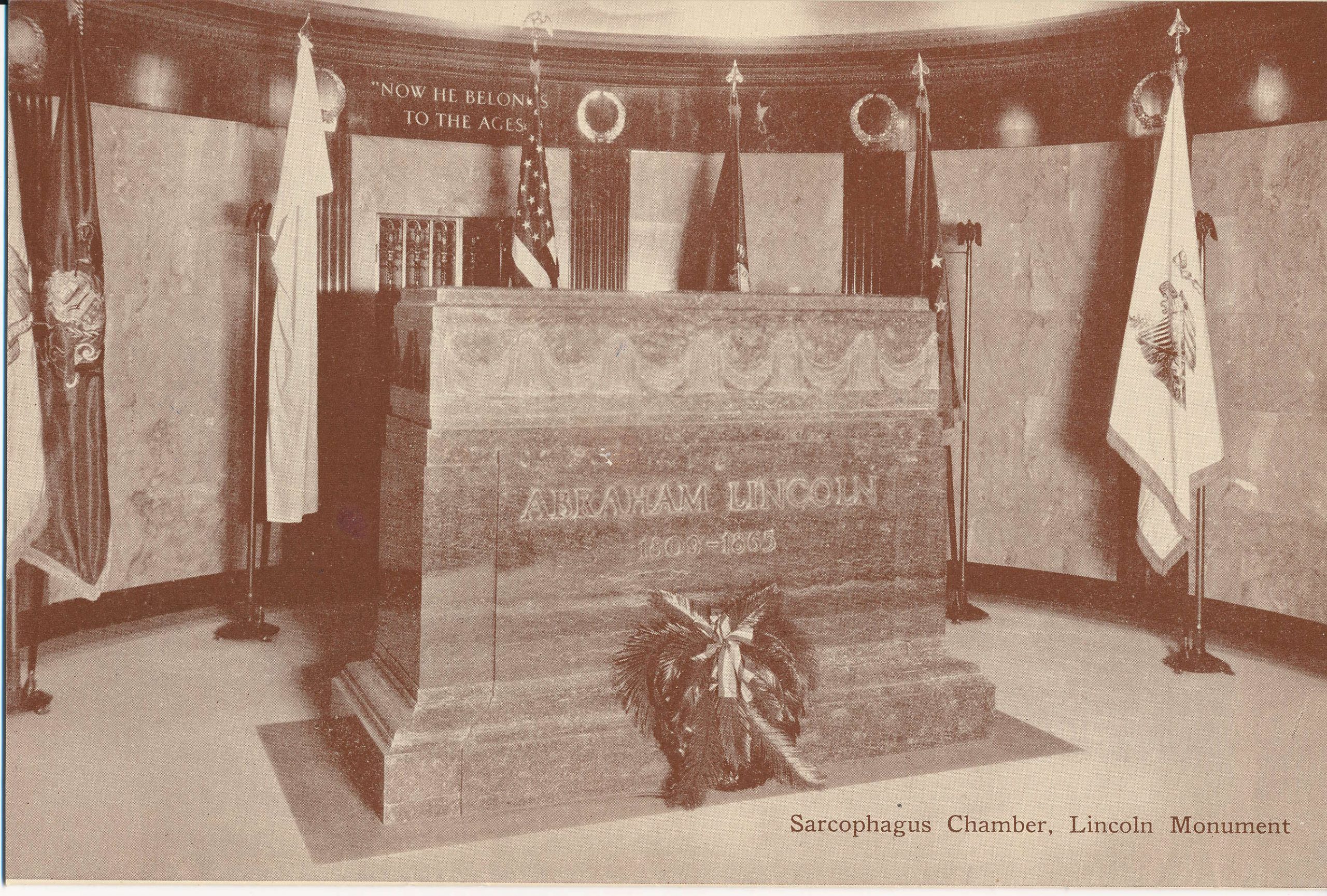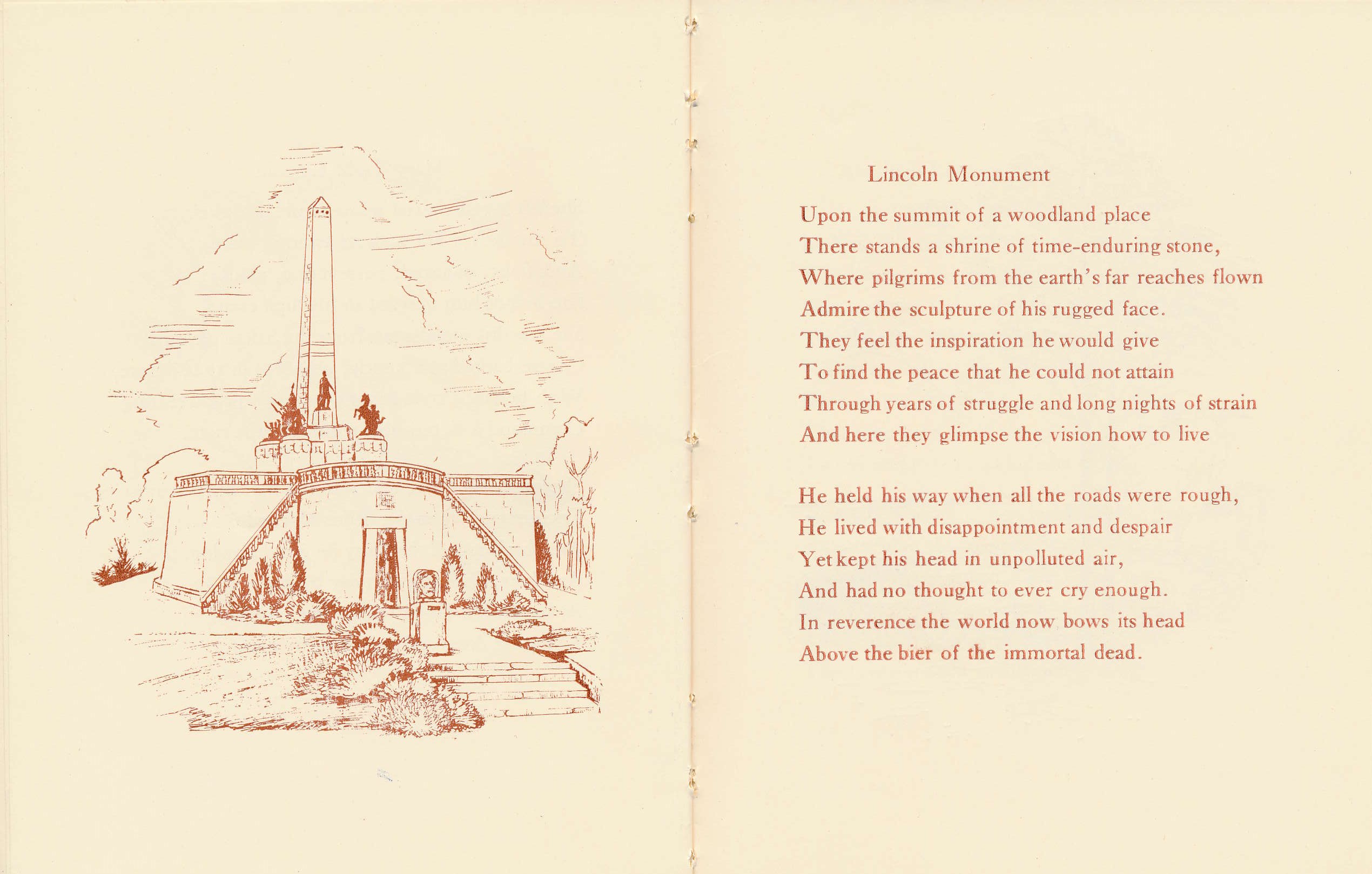
On May 4, 1865, the body of Abraham Lincoln arrived at Oak Ridge Cemetery in Springfield, Illinois. His coffin was placed in the cemetery’s receiving vault along with the coffin of his son, Willie, who had died three years earlier. In the days following, the National Lincoln Monument Association was founded by then Governor Richard J. Oglesby to construct a memorial that would honor the memory of the fallen president. Funds were raised across the country to support the cost of the memorial. Because construction would take six years, a temporary vault was built, and Lincoln’s body was placed there on December 21, 1865. The remains of Lincoln’s sons, Willie and Eddie, were also placed in the temporary tomb.

Construction for the monument began on September 10, 1869. Designed by Larkin G. Meade Jr., the monument features a 117-foot obelisk with statues of the four military groups during the Civil War (cavalry, infantry, navy, and artillery). The base of Lincoln’s tomb sits at the memorial’s north end. Guests enter at the south end in the tomb’s Memorial Hall (now called the Rotunda). Lincoln’s body was placed in the monument’s crypt on September 19, 1871, along with the bodies of Tad, Eddie, and Willie Lincoln. The body of Mary Todd Lincoln joined those of her husband and sons after her death in July 1882, while Robert Todd Lincoln is buried at Arlington National Cemetery in Arlington, Virginia.
The monument was formally dedicated on October 15, 1874, and opened to the public soon after. The National Lincoln Monument Association, which oversaw the monument and the surrounding nine acres within the cemetery, agreed to appoint and hire a custodian to manage the tomb and assist visitors.
The first appointed custodian was John C. Power, who managed the tomb from October 27, 1874, until his death in 1894. At the time of his custodianship, the National Lincoln Monument Association charged visitors 25 cents, which contributed to Power’s salary and the maintenance of the monument and its grounds. Power sold pamphlets, books, photographs, and postcards, and kept a portion of the profit. He also collected, through donations and purchases, Lincoln-related photographs, relics, and ephemera, with which he adorned Memorial Hall.

In his first annual report for 1875, Power called his first year as custodian “one of experiment” and noted that the Memorial Hall hosted four thousand annual visitors. He ended his report with:
Few allow themselves sufficient time, and in order to go over the whole ground and make each visitor feel that he or she has been profited and edified, it is absolutely necessary to talk and move with the greatest celerity; therefore, if you do not see proper to re-appoint me, let my successor be a man in vigorous health, quick in his movements, and so well acquainted with the subject that he can answer every question instantly and correctly.
It was under Power’s custodianship that, on November 7, 1876, men concocted to steal the body of Abraham Lincoln and hold it for ransom. The Secret Service received a tip about this plan, and contacted both Robert Todd Lincoln and Allan Pinkerton’s detective agency. That day, Power welcomed the prospective thieves to Lincoln’s tomb and gave them a guided tour. That night, Power, local police, two detectives, and two Secret Service agents hid on monument grounds and prevented the theft from occurring. In February 1880, the Lincoln Guard of Honor was founded to protect the body of Lincoln. Power served as the secretary of the Guard of Honor. Power is buried in Oak Ridge Cemetery, where his gravestone is inscribed “was on duty the night of Nov. 7, 1876, when ghouls attempted to steal the body of President Lincoln.”

On July 10, 1895, the State of Illinois took over management of the Lincoln monument and entrance fees to the tomb were removed. A cottage located on the grounds near the monument was built for the custodian to dwell in. Custodianship was then appointed by the governor of Illinois.
Edward S. Johnson became the second custodian of Lincoln’s tomb in 1895. Johnson was a native of Springfield whose father had been a friend of Lincoln’s. He was the first custodian to live onsite in the custodian’s cottage. He oversaw the second construction of the tomb from 1900-1901, which provided a sounder environment for the preservation of the sarcophagus. Abraham Lincoln and his last Resting Place, a pamphlet on the history of the Lincoln Tomb, was published first by Johnson in 1903, though subsequent versions of the pamphlet were published through 1924. Johnson remained custodian until his death on February 15, 1921.

Herbert Wells Fay was the third custodian of Lincoln’s tomb. He began his custodianship in 1921. A longtime collector of portraits, Fay was known as “the man with a million pictures,” and would decorate the entrance to the tomb with items from his collection. He was also known for his storytelling and extensive guided tours. Fay wrote a column titled “Tomb Notes” that was published often in the Illinois State Journal.
During Fay’s tenure, the monument was once again reconstructed and reopened on June 17th, 1931. In addition to structural changes, Memorial Hall was gutted of its relics and instead a rotunda was built for visitors to pay their respects. Fay was instructed by the State of Illinois not to tell lavish stories, but instead to create a dignified space for visitors to pay their respects to Lincoln. Fay retired from custodianship in January 1949 and died that October. His son, Earl Owen Fay, took over as the fourth custodian, but only until June 1950.

George Cashman was the fifth and final custodian of the Lincoln Tomb. Recommended for the job by Earl Owen Fay, Cashman was appointed the position by Illinois governor Adlai Stevenson. A lover of history, Cashman was a founder of the Springfield Civil War Roundtable and involved in the Sangamon County Historical Society. His wife, Dorothy, shared his love of history. Both lived in the custodian’s cottage, where they read and wrote about Lincoln and the tomb. Cashman served as custodian from 1950 until 1975.
During his time as custodian, Cashman initiated the Lincoln Tomb Ceremony, which took place each April 15th to honor the memory of Abraham Lincoln. After his retirement, the State of Illinois reorganized the administration of the tomb, and the role of custodian was dissolved. Today, the tomb is maintained by the Illinois Historic Preservation Agency.

Since its opening, the Lincoln tomb at Oak Ridge Cemetery in Springfield, Illinois, has received millions of visitors from all over the world. It was designated a National Landmark in 1960 and added to the National Register of Historic Places in 1966. All five custodians of Lincoln’s Tomb are buried within the cemetery.

Image Sources
Public Vault at Oak Ridge. From [Johnson, Edward S.]. Abraham Lincoln and His Last Resting Place. A Leaflet Published for Distribution at the National Lincoln Monument, Springfield, Illinois. Springfield, 1903.
Lincoln Tomb brochure, 1948. From MS 854: Herbert Wells Fay Collection of Lincoln Materials, 1891-1949. Folder: Lincoln’s Tomb Brochures, 1948
Arrangement of the tombs of the Lincoln family in the temporary structure, 1865-1871. Sketch. From Wall, Bernhardt. Following Abraham Lincoln, 1809-1865. Lime Rock, Conn, 1931.
Lincoln Notes Sketch. From MS 854: Herbert Wells Fay Collection of Lincoln Materials, 1891-1949. Box 1, Folder: Lincoln Drawings by H.W. Fay
Sarcophagus Chamber, Lincoln Monument. From King, Bess. The Tomb of Abraham Lincoln. Springfield, Ill: Lincoln souvenir & gift shop, 1941.
George and Dorothy Cashman in Front of Lincoln’s Tomb, by Lloyd Ostendorf, April 1970. Painting. From Cashman, George L. (George Leslie), and Edward G. Pree. A Tribute to George L. Cashman Springfield, Ill: Lincoln Deathday Association, 1990.
Oak Leaf from Tree at Lincoln’s Tomb. From MS 854: Herbert Wells Fay Collection of Lincoln Materials, 1891-1949. Box 1, Folder: Note to Grace Armstrong from H.W. Fay, June 23, 1930
“Lincoln Memorial” poem. From Perkins, Reed Miles. Descriptive Sonnets. Springfield, Ill: The Sangamon Press, 1958.
IHLC Resources
Cashman, Dorothy Moline. The Lincoln Tomb Springfield, Ill: Allied Printing, 1968.
King, Bess. The Tomb of Abraham Lincoln. Springfield, Ill: Lincoln souvenir & gift shop, 1941.
MS 854: Herbert Wells Fay Collection of Lincoln Materials, 1891-1949

I’ve grown up in Springfield over the past 50 years and have been lucky to have lived amongst those who relish in the rich history of our great city. I remember visiting Lincolns tomb for the first time as a young child. Later I recall riding my bicycle to the old vault and Lincolns tomb pondering on the significant lives of all those buried in Oakridge.